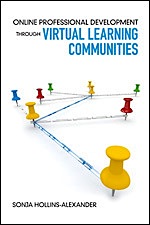Online Professional Development Through Virtual Learning Communities
Online Professional Development Through Virtual Learning Communities
By Sonja Hollins-Alexander
(Corwin/Sage, 2013 – Learn more)
In my quest to support new teachers who become employed in rural and disparate communities with varying degrees of support, I was interested in reviewing the book, Online Professional Development Through Virtual Learning Communities. Sonja Hollins-Alexander’s book highlights her experiences as a director of professional learning and her progress toward moving face-to-face professional development in a large urban school district to one supplemented and ultimately heavily supplanted by virtual learning communities.
Although this shift was a significant feat, the context of this book and its recommendations constrain the applicability of this text to a more limited audience, primarily that of professional development organizations, district level specialists, and possibly even those educators in larger systems that would have the capacity to implement such a program.

Chapters 2 and 3 provide an overview of 10 key questions that individuals beginning to develop virtual learning communities should ask and answer and 10 action steps associated developing such communities. Chapters 4 through 6 address several of the questions and action steps identified in chapters 2 and 3 in more detail.
First, the author discusses the process of transitioning from face-to-face to virtual professional development opportunities along with the general format of the professional development itself. This model focuses on a learn, discuss, learn, discuss structure with adequate reflection. Next, the necessary support structures to meet district priorities and move to this model are identified, including in-house instructional designers and course design. Hollins-Alexander describes the method used to support the building of capacity and sustainability: locating and training facilitators, creating school-based cohorts, and creating an online facilitator course to continue to support the virtual learning communities.
Chapter 7 identifies potential pitfalls to moving to a virtual communities learning model for online teacher professional development. The author provides a brief explanation of what was done to overcome these obstacles. The biggest challenge noted by Hollins-Alexander is identifying the impact of the VLCs on student learning. Indeed, at the time of writing, there was no evidence that this professional development model was effective in positively impacting teaching and learning outcomes. She indicates that this evaluation is currently taking place and will be provided as it becomes available.
(Editor’s note: In November 2013, Hollins-Alexander led a free webinar on this topic, archived at the Learning Forward website.)
Useful system-level information
Through outlining her experience in creating virtual communities of practice, Hollins-Alexander provides a useful justification and suggestions for moving to virtual communities. Those looking to justify such a transition can find some support in this book. Importantly, she also supports the call for professional development to transition from the sit-and-get process often experienced by teachers, to a more in-time and interactive experience. Additionally, the book presents information about challenges experienced and how those were overcome.
While this text provides a general outline for implementation of virtual learning communities in a large urban school district, the limited applicability of the book to a broad audience makes it less appropriate for the vast majority of the MiddleWeb readership. In addition, in an attempt to simplify the process into “steps,” the book at times becomes repetitive and disjointed. Though there are definite weaknesses in this book, given the right reader, it could provide some useful information to support the transition to, or development of, virtual learning communities.
Dr. Nicole C. Miller is a faculty member in the Department of Curriculum, Instruction and Special Education at Mississippi State University. She previously worked as a social studies and educational technology teacher/coordinator at a Los Angeles middle school. Her current research interests include middle level teacher preparation and technology integration, including using technology to support teacher learning.































